
eBook - ePub
Drainage Details
L. Woolley
This is a test
Condividi libro
- 104 pagine
- English
- ePUB (disponibile sull'app)
- Disponibile su iOS e Android
eBook - ePub
Drainage Details
L. Woolley
Dettagli del libro
Anteprima del libro
Indice dei contenuti
Citazioni
Informazioni sul libro
A unique set of 45 information sheets giving complete details of all forms of drainage work for the builder and surveyor.
Domande frequenti
Come faccio ad annullare l'abbonamento?
È semplicissimo: basta accedere alla sezione Account nelle Impostazioni e cliccare su "Annulla abbonamento". Dopo la cancellazione, l'abbonamento rimarrà attivo per il periodo rimanente già pagato. Per maggiori informazioni, clicca qui
È possibile scaricare libri? Se sì, come?
Al momento è possibile scaricare tramite l'app tutti i nostri libri ePub mobile-friendly. Anche la maggior parte dei nostri PDF è scaricabile e stiamo lavorando per rendere disponibile quanto prima il download di tutti gli altri file. Per maggiori informazioni, clicca qui
Che differenza c'è tra i piani?
Entrambi i piani ti danno accesso illimitato alla libreria e a tutte le funzionalità di Perlego. Le uniche differenze sono il prezzo e il periodo di abbonamento: con il piano annuale risparmierai circa il 30% rispetto a 12 rate con quello mensile.
Cos'è Perlego?
Perlego è un servizio di abbonamento a testi accademici, che ti permette di accedere a un'intera libreria online a un prezzo inferiore rispetto a quello che pagheresti per acquistare un singolo libro al mese. Con oltre 1 milione di testi suddivisi in più di 1.000 categorie, troverai sicuramente ciò che fa per te! Per maggiori informazioni, clicca qui.
Perlego supporta la sintesi vocale?
Cerca l'icona Sintesi vocale nel prossimo libro che leggerai per verificare se è possibile riprodurre l'audio. Questo strumento permette di leggere il testo a voce alta, evidenziandolo man mano che la lettura procede. Puoi aumentare o diminuire la velocità della sintesi vocale, oppure sospendere la riproduzione. Per maggiori informazioni, clicca qui.
Drainage Details è disponibile online in formato PDF/ePub?
Sì, puoi accedere a Drainage Details di L. Woolley in formato PDF e/o ePub, così come ad altri libri molto apprezzati nelle sezioni relative a Architektur e Architektur Methoden & Materialien. Scopri oltre 1 milione di libri disponibili nel nostro catalogo.
Informazioni
Town Drainage Schemes
CI/SfB(52)
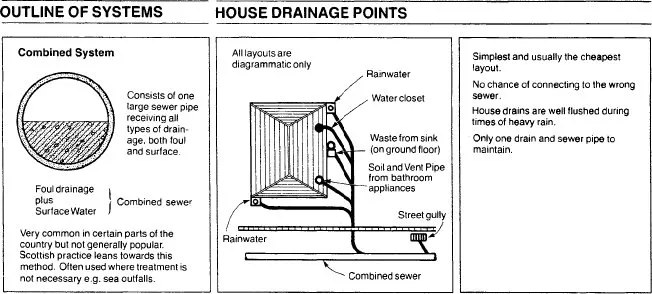

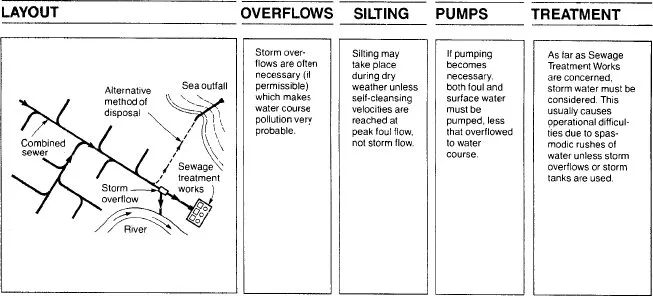
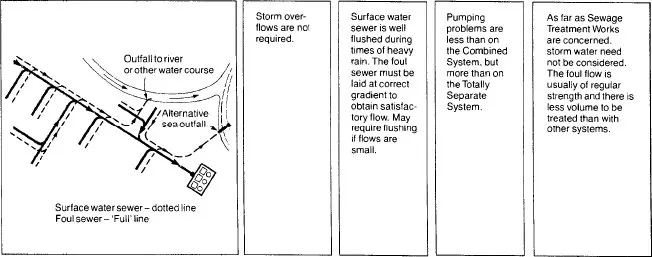
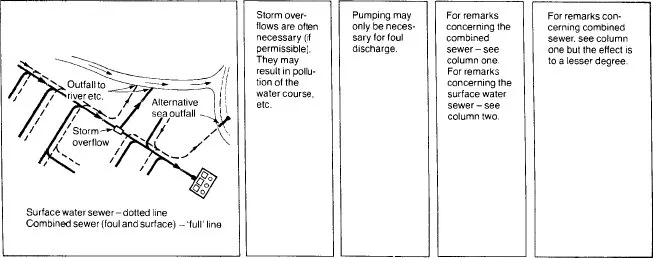
Aim and Design Considerations
CI/SfB(52)
Aim
The aim is to provide a system of self cleansing pipework for -
- the conveyance of foul waste and surface water.
- Speedily and efficiently to the sewer or other outfall,
- Without risk of nuisance or danger to health.
Design Considerations

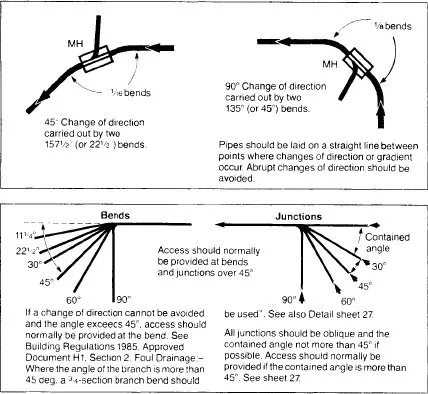

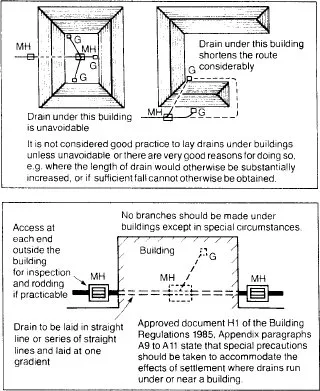
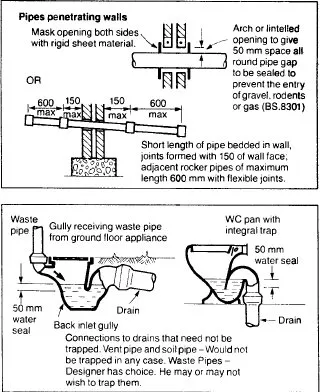
See Approved Document H1, table 2, of the Building Regulations 1985 for minimum trap sizes and seal depths.
Appliance | Diaof Trap mm | Depth of seal mm |
Washbasin, bidet | 32 | 75 |
Sink, bath, I shower, food waste disposal unit, urinal bowl | 40 | 75 |
WC Pan | 75(min) | 50 |
All points of discharge into the system should be fitted with a water seal (trap) to prevent foul air from the system entering into the building underworking.
The distances between access points depend on the types of access used but should not be more than shown in Table 10 of Document H1 of the Building Regulations 1985 for drains up to and including 300 mm.
Definitions
- Surface water. The run-off natural water from ground surface including paved areas, roofs and unpaved lands.
- Waste water. Water not contaminated by soil water or trade effluent can be taken as the discharge from lavatory basins, baths, sinks and similar appliances.
- Soil water. The discharge from a soil appliance such as water closet, urinal receptacle, bed pan washer, slop sink, etc.
- Foul drain. A drain normally designed to take the discharge of both soil and waste water (may also receive trade effluent).
- Waste drain. To receive waste water as distinct from soil and trade effluent.
- Surface water drain. To receive surface water exclusively.
- Inspection chamber. Chamber constructed on a drain so as to provide access thereto for inspection and cleansing (often called "manhole").
Schemes for Town Houses
CI/SfB(52)
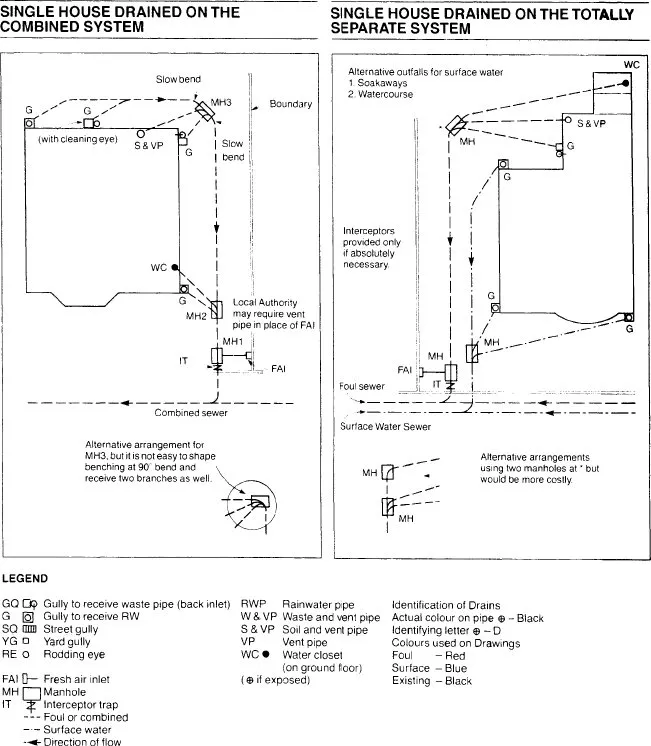
Group of Houses Drained on the Partially Separate System
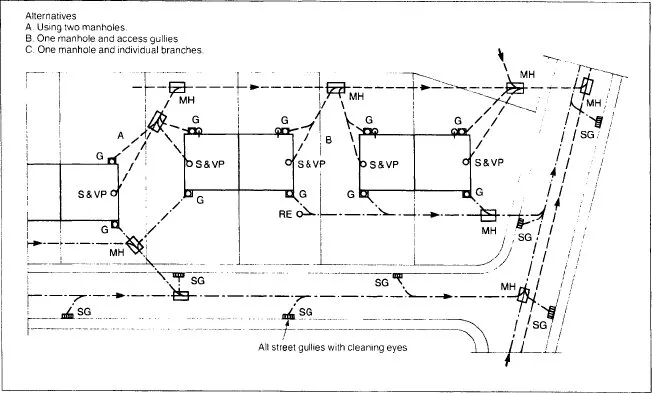
Group of Houses Drained on the Combined System
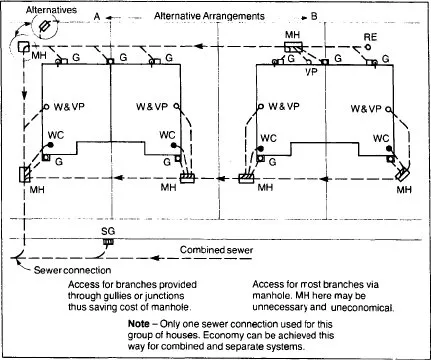
Terraced House

Schemes for Country Houses
CI/SfB(52)
Septic Tanks
In recent years the prefabricated grp septic tanks has tended to supersede the conventional brick or concrete ring units -offering simplicity of installation and cost benefits.
The Septic tank is still a common method of disposing sewage and waste water from single properties and small communities. It provides an environment where gross solids may settle out and where this stored organic matter may undergo anaerobic decomposition. The partially treated liquor then flows to a network of sub-surface irrigation drains to be discharged into the land.
The efficiency of the tank system relies on the suitability of the sub-soil to accept the volume of liquor without causing pollution. Where the sub-soil has a high clay content or similar non-absorbent material, or where there is a high level of ground water, septic tanks will not operate effectively.
Percolation tests will determine the suitability of a particular site for sub-surface irrigation - and details of these tests are set out in BSCP 6297:1983.
Klargester Environmental Engineering makes Septic Tanks in accordance with the Code of Practice, providing a daily flow allowance of at least 180 litres per person on the system, plus a further 2000 litres. Settled sludge is required to be removed from the tank once every year.
Problems experienced with septic tank installations can often be related to the failure to consider either the site ground conditions (soil porosity, high water table) or the requirement for regular de-sludging.
The design feature of the Klargester unit is to prevent gross solids being flushed through the system. This is achieved by means of a series of baffles within the tank creating an upward flow of effiuent through individual stages prior to discharge. Where the ground adjacent to the tank is unsuitable for sub-surface irrigation, a simple pumpset incorporating a prefabricated grp sump may be used to pump the effluent to a remote area where the ground is more suitable.
Care should be taken to instal the tank in accordance with the manufacturer‘s instructions.
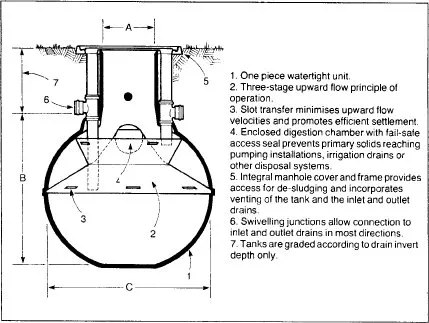

Cesspools
With certain drainage problems, septic tanks may not provide the answer - but the use of a cesspool might. By design, a cesspool is a watertight construction for storing sewage; and difficulties in obtaining a watertight construction for storing sewage have now been generally overcome by using prefabricated glass fibre tanks, which also make installation simpler.
Its physical size can make the installation of a cesspool of the minimum recommended capacity of 18,000 litres a costly business. But, one of the biggest disadvantages could be the recurring emptying costs. An average four-person family could fill the tank in between five and eight we...